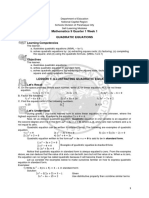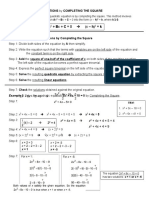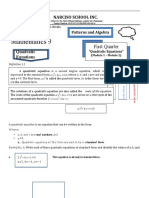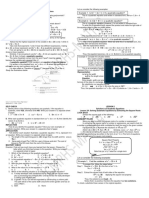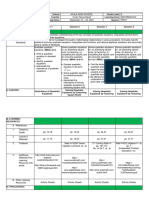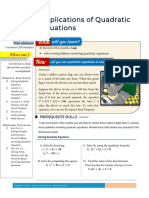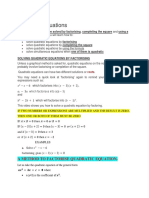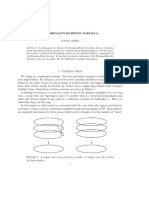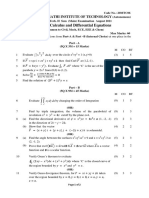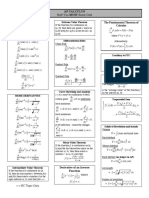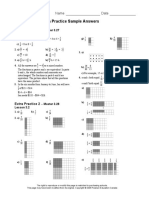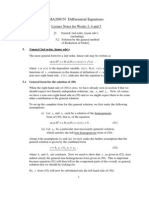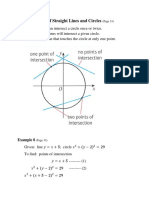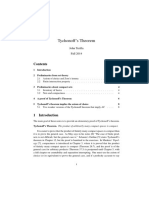Module 9 Study Guide
Uploaded by
zithzith5408Module 9 Study Guide
Uploaded by
zithzith5408BRIDGE MATHEMATICS 1 (BM 101-A) FACULTY OF EDUCATION
UPOU UGNAYAN NG PAHINUNGOD
MODULE 9: SOLVING QUADRATIC EQUATIONS
AND RADICAL EXPRESSIONS
Meet Your Target
At the end of the module, each Bridge Math
participant will be able to:
• solve quadratic equations using factoring,
extracting square roots, and completing the
square;
• use quadratic formula in solving quadratic
equations in standard form;
• use the discriminant of a quadratic
equation to identify the nature of expected
solutions;
• perform
simplifyoperations
radical expressions; and
on radical expressions; and
• solve radical equations
Activate the Mind
TOPIC 1: INTRODUCTION TO
QUADRATIC EQUATIONS
In Module 8, you have reviewed about linear
equations. These are equations with a
degree of 1. For example, x + y = 8 or x + 5 =
8. The graph of the linear equation is a line.
In this module, you will review another type of
equation. These are quadratic equations. Based on the table below, describe quadratic
equations.
EXAMPLES OF NON-EXAMPLES OF
QUADRATIC EQUATIONS QUADRATIC EQUATIONS
x2 = 9 x + 4 = 10
x 2 + 3x = 10 x 3 + 2x 2 − 3x + 15 = 0
x 2 + y 2 = 25 x = 25
Now, what are quadratic equations?
Bridge Mathematics Course Module designed by LGV Pondara | Module 9
Faculty of Education, UP Open University (2022) | Page 128
BRIDGE MATHEMATICS 1 (BM 101-A) FACULTY OF EDUCATION
UPOU UGNAYAN NG PAHINUNGOD
DEFINITION OF A QUADRATIC EQUATION
A quadratic equation in one variable is an equation of the standard form
ax 2 + bx + c = 0
where a, b, and c are real numbers and a ≠ 0. The degree of a quadratic equation is 2.
In the equation,
Exercise 1: Determine whether each equation is quadratic or not.
GIVEN EQUATION QUADRATIC OR NOT?
1) x +3= 0 Not Quadratic
2) x 2 + 10 = 3x Quadratic
3) 2(x + 3)2 = 0 Quadratic
If you will expand the equation, you will have
2(x2 + 6x + 9) = 0
2x2 +12x + 18 = 0
4) x − 2 = 80 Not Quadratic
5) x 3 = 27 Not Quadratic
6) x 2 − 2x − 80 = 0 Quadratic
7) 5m 2 − 2m + 10 = 0 Quadratic
Even if the variable is m, the degree of the
polynomial is still 2.
TOPIC 2: SOLVING FOR THE ROOTS OF QUADRATIC EQUATIONS
REVIEW ON PERFECT SQUARES
Perfect square numbers are numbers that have an integral root. These are some of the
perfect square numbers:
1 since 1 = 1 or − 1 25 since 25 = 5 or − 5
4 since 4 = 2 or − 2 100 since 100 = 10, − 10
9 since 9 = 3 or − 3 225 since 225 = 15, − 15
The values that satisfy an equation are called solutions. In a quadratic equation, these are
called roots.
There are four ways to nd the roots of quadratic equations:
1. Extracting the Square Root
2. Factoring
3. Completing the Square
4. Using the Quadratic Formula
Bridge Mathematics Course Module designed by LGV Pondara | Module 9
Faculty of Education, UP Open University (2022) | Page 129
fi
BRIDGE MATHEMATICS 1 (BM 101-A) FACULTY OF EDUCATION
UPOU UGNAYAN NG PAHINUNGOD
SOLVING QUADRATIC EQUATIONS BY EXTRACTING SQUARE ROOTS
The Square Root Property
Let x be an algebraic expression and d be any real numbers:
= d, then x = ± d .
If x 2
It is the same as x = d and x = − d.
How to solve quadratic equations by extracting square roots:
Step 1. Write the given quadratic equation in the form x 2 = d.
Step 2. Apply the square root property.
Step 3. Check if the roots satisfy the equation.
Exercise 1: Solve the following equations by extracting the square roots.
a) x 2 − 121 = 0
b) 3x 2 − 27 = 0
Solutions:
a) x 2 − 121 = 0
x 2 = 121 Write the given equation in the form x2 = d.
x 2 = 121 Apply the square root property.
x = ± 11
b) 3x 2 − 27 = 0
3x 2 = 27 Write the given equation in the form x2 = d.
3x 2 27 Divide both sides by 3.
=
3 3
x2 = 9
Apply the square root property.
x2 = 9
x =±3
Imaginary Roots
Let x be an algebraic expression and d be any real numbers:
If x 2 = − d, then x = ± di.
If d < 0, then there are no real roots, but there are imaginary roots.
An imaginary unit i is de ned as i 2 = − 1 or i = −1 .
For example, simplify −9 . −9 = (9)( − 1) = 9 −1 = ± 3i
Bridge Mathematics Course Module designed by LGV Pondara | Module 9
Faculty of Education, UP Open University (2022) | Page 130
fi
BRIDGE MATHEMATICS 1 (BM 101-A) FACULTY OF EDUCATION
UPOU UGNAYAN NG PAHINUNGOD
Exercise 2: Solve the following equations by extracting the square roots.
a) x 2 + 121 = 0
b) 5x 2 = − 30
Solutions:
a) x 2 + 121 = 0
x 2 = − 121 Write the given equation in the form x2 = d.
x 2 = (121)( − 1) Apply the square root property.
x = ± 11i
b) 5x 2 = − 30
5x 2 −30 The equation is already in the form x2 = d. Divide
=
5 5 both sides by 5.
x2 = − 6
x 2 = −6 Apply the square root property.
x = ± 6i
Exercise 3: The middle portion of a stage is to be covered with a red carpet. The carpet is a
square with an area of 64 m2. What is the length of the side of the carpet?
Solution: Length = ?
Let x = length of the side of the square
Area = 64 m2
Area of a square = x2
64 m 2 = x 2
64 m 2 = x 2 Note: Not to scale
x =±8m
Since the length of the side of the carpet is always positive, then we only take the positive
value. The length of the side of the carpet is 8 meters.
SOLVING QUADRATIC EQUATIONS BY FACTORING
Zero Product Property
If the product of two algebraic expressions is zero, then
at least one of the factors is equal to zero.
i fA B = 0, then A = 0 or B = 0.
How to solve quadratic equations by factoring:
Step 1. Write the equation in standard form a x 2 + bx + x = 0.
Step 2. Factor the quadratic trinomial of the equation.
Step 3. Apply the Zero Product Property.
Step 4. Check if the roots satisfy the equation.
Bridge Mathematics Course Module designed by LGV Pondara | Module 9
Faculty of Education, UP Open University (2022) | Page 131
BRIDGE MATHEMATICS 1 (BM 101-A) FACULTY OF EDUCATION
UPOU UGNAYAN NG PAHINUNGOD
Exercise 2: Find the roots of the following quadratic equations by factoring.
a) x 2 + 12x + 36 = 0
b) x 2 − x − 20 = 0
c) 3x 2 + 2x = 8
Solutions:
a) x 2 + 12x + 36 = 0
(x + 6)(x + 6) = 0 Factor the quadratic trinomial.
First factor,
x +6=0 Apply the zero product property.
x =−6
Second factor,
x +6=0
x =−6
The root is -6 with multiplicity 2. State the roots of the quadratic equation.
It means that there are two -6 roots.
b) x 2 − x − 20 = 0
(x + 4)(x − 5) = 0 Factor the quadratic trinomial.
First factor,
x +4=0 Apply the zero product property.
x =−4
Second factor,
x −6= 0
x =5
The roots are -4 and 5. State the roots of the quadratic equation.
c) 3x 2 + 2x = 8
2
3x + 2x − 8 = 0 Write the equation in standard form.
(x + 2)(3x − 4) = 0 Factor the quadratic trinomial.
First factor,
x +2 = 0
x =−2 Apply the zero product property.
Second factor,
3x − 4 = 0
3x = 4
4
x=
3
4
The roots are -2 and .
3 State the roots of the quadratic equation.
Bridge Mathematics Course Module designed by LGV Pondara | Module 9
Faculty of Education, UP Open University (2022) | Page 132
BRIDGE MATHEMATICS 1 (BM 101-A) FACULTY OF EDUCATION
UPOU UGNAYAN NG PAHINUNGOD
Exercise 3: Paulo plans to build a rectangular swimming pool in his backyard. The swimming
pool area must be 96 square feet, and its perimeter must be 40 feet. Find the length and width
of the pool.
Perimeter = 40
Solution:
Let l = length of the pool
Width = ?
w = width of the pool Area = 96 2
The area of the pool must be 96 square feet. Thus,
l w = 96 (equation 1)
Length = ?
The perimeter of the pool must be 40 feet. Thus,
2l + 2w = 40 (equation 2)
96
Deriving l in terms of w in equation 1, l=
w
Substituting the value of l in equation 2,
(w)
96 Substituting l = 96/w in equation 2.
2 + 2w = 40
192
+ 2w = 40
w
( w )
192
w + w (2w) = w (40) Multiplying w in all terms.
192 + 2w 2 = 40w
2w 2 − 40w + 192 = 0 Writing the equation in standard form.
2(w 2 − 20w + 96) = 0 Factoring the equation by its GCF, 2.
2(w 2 − 20w + 96)
Dividing both sides by 2.
0
=
2 2
w 2 − 20w + 96 = 0
(w − 12)(w − 8) = 0 Factoring the quadratic trinomial.
First factor,
w − 12 = 0 Applying the Zero Product Property.
w = 12 fee t
Second factor,
w −8= 0 Applying the Zero Product Property.
w = 8 fee t
There are two possible values.
If width = 12 feet, then Substituting the values of w to nd the value of l.
96
l e ngth = = 8 fee t
12
If width = 8 feet, then
96
l e ngth = = 12 fee t
8
The length should be longer than the width. Thus, the length of the pool is 12 feet, while
its width is 8 feet.
Bridge Mathematics Course Module designed by LGV Pondara | Module 9
Faculty of Education, UP Open University (2022) | Page 133
f
f
fi
BRIDGE MATHEMATICS 1 (BM 101-A) FACULTY OF EDUCATION
UPOU UGNAYAN NG PAHINUNGOD
SOLVING QUADRATIC EQUATIONS BY COMPLETING THE SQUARE
Some trinomials cannot be factored. So, we cannot use the factoring method. Instead, we use
another method called completing the square to nd the roots of the quadratic equation.
The aim is to make a trinomial that is a perfect square trinomial.
Completing the Square
(2)
2
b
Let x 2 ± b x be a binomial expressing. Adding to the
binomial makes it a perfect square trinomial. Thus,
(2) ( 2)
2 2
b b
x ± bx +
2
= x±
How to solve quadratic equations by completing the square:
Step 1. Write the equation in standard form a x 2 + b x + c = 0.
Step 2. Be sure that the numerical coe cient of x2 is 1, or the value of a = 1.
Step 3. Move the constant term c to the right-hand side of the equation.
Step 4. Add the square of one-half of the numerical coe cient of x to both sides
(2)
2
b
of the equation,
Step 5. Factor the left-hand side of the equation.
Step 6. Find the value of x by applying the square root property.
Step 7. Check if the roots satisfy the equation.
Exercise 2: Find the roots of the equation.
a) x 2 − 10x + 19 = 0 b) x 2 + 8x − 33 = 0 c) 3x 2 − 7x = 6
Solution:
a) x 2 − 10x + 19 = 0
x 2 − 10x = − 19 Step 3. Move the constant term c to the right-hand
side of the equation.
( 2 ) ( 2 )
2 2
10 10
(2)
2
x 2 − 10x + = − 19 + b
Step 4. Add to both sides of the equation.
x 2 − 10x + 25 = − 19 + 25
Simplify
x 2 − 10x + 25 = 6
(x − 5)2 = 6 Step 5. Factor the left-hand side of the equation.
Step 6. Apply the square root property.
(x − 5)2 = 6
Solve for the roots.
x −5=± 6
x =5± 6
The roots are 5 + 6 and 5 − 6.
Bridge Mathematics Course Module designed by LGV Pondara | Module 9
Faculty of Education, UP Open University (2022) | Page 134
ffi
fi
ffi
BRIDGE MATHEMATICS 1 (BM 101-A) FACULTY OF EDUCATION
UPOU UGNAYAN NG PAHINUNGOD
b) x 2 + 8x − 33 = 0
x 2 + 8x = 33 Step 3. Move the constant term c to the right-hand
side of the equation.
(2) (2)
2 2
8 8
(2)
2
x 2 + 8x + = 33 + b
Step 4. Add to both sides of the equation.
x 2 + 8x + 16 = 33 + 16
Simplify
x 2 + 8x + 16 = 49
(x + 4)2 = 49 Step 5. Factor the left-hand side of the equation.
Step 6. Apply the square root property.
(x + 4)2 = 49
x +4 =±7
First root, Solve for the roots.
x +4=7
x =7−4
x =3
Second root,
x +4 =−7
x =−7−4
x = − 11
The roots are -11 and 3.
c) 3x 2 − 7x = 6
3x 2 − 7x = 6 Step 3. Move the constant term c to the right-hand
side of the equation.
3x 2 7x 6 Step 2. Divide all terms by 3 to make the numerical
− =
3 3 3 coefficient of x2 = 1.
7
x2 − x = 2
3
2 2
b 2
(2)
7 7
7 3 3 Step 4. Add to both sides of the equation.
x2 − x + =2+
3 2 2
7 49 49
x2 − x+ =2+ Simplify
3 36 36
7 49 121
x2 − x+ =
3 36 36
Bridge Mathematics Course Module designed by LGV Pondara | Module 9
Faculty of Education, UP Open University (2022) | Page 135
BRIDGE MATHEMATICS 1 (BM 101-A) FACULTY OF EDUCATION
UPOU UGNAYAN NG PAHINUNGOD
7 2 121
( 6)
x− = Step 5. Factor the left-hand side of the equation.
36
7 2
( 6)
121
x− = Step 6. Apply the square root property.
36
7 11
x− =±
6 6
7 11
x = ±
6 6
First root,
Solve for the roots.
7 11 18
x = + = =3
6 6 6
Second root,
7 11 −4 2
x = − = =−
6 6 6 3
2
The roots are 3 and − .
3
Exercise 3: The product of two consecutive odd natural numbers is 399. Find the sum of the
squares of the numbers.
Solution:
Let x = rst odd number
x + 2 = second odd number
Equation:
x(x + 2) = 399 Equation
x 2 + 2x = 399 Expand the expression.
(2)
2
(2) (2)
2 2
2 2 b
x 2 + 2x + = 399 + Step 4. Add to both sides of the equation.
2
x + 2x + 1 = 399 + 1 Simplify
(x + 1)2 = 400 Step 5. Factor the left-hand side of the equation.
Step 6. Apply the square root property.
(x + 1)2 = 400
x + 1 = ± 20
First root, Solve for the roots.
x = − 1 + 20 = 19
Second root,
x = − 1 − 20 = − 21
Since we only look for odd natural numbers,
then we eliminate the possibility of -21.
If x = 19, then x + 2 = 2.
The sum of their squares is, 192 + 212 = 361 + 441 = 802.
Bridge Mathematics Course Module designed by LGV Pondara | Module 9
Faculty of Education, UP Open University (2022) | Page 136
fi
BRIDGE MATHEMATICS 1 (BM 101-A) FACULTY OF EDUCATION
UPOU UGNAYAN NG PAHINUNGOD
SOLVING QUADRATIC EQUATIONS BY USING THE QUADRATIC FORMULA
Aside from extracting the square roots, factoring, and completing the square, another way to
solve for the roots of the quadratic equation is by using the quadratic formula.
The Quadratic Formula
Given the standard form a x 2 + b x + c = 0 where a ≠ 0,
the roots are given the quadratic formula
−b ± b 2 − 4a c
x=
2a
How to solve quadratic equations by using the quadratic formula:
Step 1. Write the equation in standard form a x 2 + bx + c = 0.
Step 2. Determine the numerical values for a, b, and c.
Step 3. Substitute the values of a, b, and c in the quadratic formula and evaluate
the expression.
Step 4. Check if the roots satisfy the equation.
Exercise 1: Find the roots of the equation using the quadratic formula.
a) x 2 + 8x − 33 = 0 b) x 2 − 10x + 19 = 0
Solution:
a) x 2 + 8x − 33 = 0 Step 1. The equation is in standard form.
a = 1, b = 8, c = − 33 Step 2. Determine the values of a, b, and c.
−b ± b 2 − 4a c Use the quadratic formula.
x=
2a
Step 3. Substitute the values.
−8 ± (−8)2 − 4(1)( − 33)
x =
2(1)
−8 ± 64 + 132 Simplify.
x =
2
−8 ± 196
x =
2
−8 ± 14
x =
2
First root,
Solve for the roots.
−8 + 14
x =
2
6
x =
2
x =3
Bridge Mathematics Course Module designed by LGV Pondara | Module 9
Faculty of Education, UP Open University (2022) | Page 137
BRIDGE MATHEMATICS 1 (BM 101-A) FACULTY OF EDUCATION
UPOU UGNAYAN NG PAHINUNGOD
Second root, Solve for the roots.
−8 − 14
x =
2
22
x =−
2
x = − 11
The roots are -11 and 3.
b) x 2 − 10x + 19 = 0 Step 1. The equation is in standard form.
a = 1, b = − 10, c = 19 Step 2. Determine the values of a, b, and c.
−b ± b 2 − 4a c Use the quadratic formula.
x=
2a
−( − 10) ± (−10) − 4(1)(19) Step 3. Substitute the values.
2
x =
2(1)
10 ± 100 − 76 Simplify.
x =
2
10 ± 24 Solve for the roots.
x =
2
10 ± 2 6
x =
2
2(5 ± 6)
x =
2
x =5± 6
The roots are 5 + 6 and 5 − 6.
Link to Resource Materials:
Quadratic Equations by Virtual Math Lab, West Texas A & M University
https://www.wtamu.edu/academic/anns/mps/math/mathlab/col_algebra/
col_alg_tut17_quad.htm
Quadratic Equations and Word Problems by Math is Fun
https://www.mathsisfun.com/algebra/quadratic-equation.html
https://www.mathsisfun.com/algebra/quadratic-equation-real-world.html
Bridge Mathematics Course Module designed by LGV Pondara | Module 9
Faculty of Education, UP Open University (2022) | Page 138
BRIDGE MATHEMATICS 1 (BM 101-A) FACULTY OF EDUCATION
UPOU UGNAYAN NG PAHINUNGOD
Try This
Links to Online Quizzes:
Quadratic Equations by IXL
https://www.ixl.com/math/algebra-1/solve-a-quadratic-equation-by-
factoring
Quadratic Equations by Mathopolis
https://bit.ly/quadraticequationsmathopolis
Quadratic Equations by Paul’s Online Notes (1)
https://tutorial.math.lamar.edu/problems/alg/
solvequadraticeqnsi.aspx
Quadratic Equations by Paul’s Online Notes (2)
https://tutorial.math.lamar.edu/Problems/Alg/
SolveQuadraticEqnsII.aspx
Word Problems by Paul’s Online Notes
https://tutorial.math.lamar.edu/Problems/Alg/QuadraticApps.aspx
Practice is the secret to mastery. Do you nd it challenging? Practice!
Try these online quizzes on solving roots of quadratic equations by IXL,
Mathopolis, Paul’s Online Notes 1, and Paul’s Online Notes 2. You can
also try answering word problems on quadratic equations by Paul’s Online
Notes. You can either scan the QR code or click the link.
Activate the Mind
TOPIC 2: NATURE OF THE ROOTS OF QUADRATIC EQUATIONS
DEFINITION OF A DISCRIMINANT
−b ± b 2 − 4a c
In the quadratic formula x = ,
2a
the radicand b 2 − 4a c is called the discriminant.
The discriminant may be zero, positive and rational,
positive and irrational, or negative.
Bridge Mathematics Course Module designed by LGV Pondara | Module 9
Faculty of Education, UP Open University (2022) | Page 139
fi
BRIDGE MATHEMATICS 1 (BM 101-A) FACULTY OF EDUCATION
UPOU UGNAYAN NG PAHINUNGOD
−b ± b 2 − 4a c
In the quadratic formula x = , the radicand b 2 − 4a c can be used to describe
2a
the nature of the roots of the quadratic equation. You do not need to solve the whole formula to
determine the nature of its roots.
NATURE OF ROOTS
Let D = b 2 − 4a c.
Value of D Nature of Roots
D=0 Roots are real and equal.
(The discriminant is equal to 0.)
D > 0 and D is a perfect square. Roots are real, rational,
(The discriminant is positive and a perfect square) and not equal.
D > 0 and D is not a perfect square. Roots are real, irrational,
(The discriminant is positive, but not a perfect square) and not equal.
D<0 Roots are not real.
(The discriminant is negative) They are imaginary.
Exercise 1: Find the value of the discriminant for each equation. Then, describe the nature of
the roots.
a. 2x 2 − 5x − 3 = 0 c. x 2 − x + 2 = 0
2
b. x + 5x + 3 = 0 d. x 2 + 2x + 1 = 0
Solution:
GIVEN EQUATION DISCRIMINANT NATURE OF ROOTS
a. 2x 2 − 5x − 3 = 0 a = 2, b = − 5, c = − 3 Roots are real numbers,
rational, and not equal.
D = b 2 − 4a c
D = (−5) − 4(2)( − 3)
2
D = 25 + 24
D = 49
D > 0 a n d i s a pe r fe c t sq u a r e .
b. x 2 + 5x +3=0 a = 1, b = 5, c = 3 Roots are real numbers,
irrational, and not equal.
D = b 2 − 4a c
D = (5) − 4(1)(3)
2
D = 25 − 12
D = 13
D > 0 bu t n o t a pe r fe c t sq u a r e
Bridge Mathematics Course Module designed by LGV Pondara | Module 9
Faculty of Education, UP Open University (2022) | Page 140
BRIDGE MATHEMATICS 1 (BM 101-A) FACULTY OF EDUCATION
UPOU UGNAYAN NG PAHINUNGOD
GIVEN EQUATION DISCRIMINANT NATURE OF ROOTS
c. x2 − x + 2 = 0 a = 1, b = − 1, c = 2 Roots are not real numbers.
They are imaginary.
D = b 2 − 4a c
D = (−1)2 − 4(1)(2)
D =1−8
D =−7
D <0
d. x 2 + 2x +1=0 a = 1, b = 2, c = 1 Roots are real numbers and
equal.
D = b 2 − 4a c
D = (2)2 − 4(1)(1)
D = 4−4
D =0
Try This
Identify the nature of the roots of the quadratic equation. You can try this
online quiz by Quizziz. You can either scan the QR code or click the link.
Link to Online Quiz via Quizziz:
https://quizizz.com/admin/quiz/5c73aeebfbb1eb001adab3ca/quadratic-equations-nature-of-
the-roots
Activate the Mind
TOPIC 3: RADICALS - AN INTRODUCTION
The symbol is used to indicate the radical expression. It is called the radical sign. The
number under the radical sign is called the radicand. The index is n.
THE RELATION BETWEEN AN EXPRESSION WITH A
RATIONAL EXPONENT AND A RADICAL EXPRESSION
m
If a is a real number and is a rational number where n is a positive integer
n
n
greater than or equal to 2, then a m/n = a m
Bridge Mathematics Course Module designed by LGV Pondara | Module 9
Faculty of Education, UP Open University (2022) | Page 141
BRIDGE MATHEMATICS 1 (BM 101-A) FACULTY OF EDUCATION
UPOU UGNAYAN NG PAHINUNGOD
Note:
If n is even, then a must be a non-negative number.
If n is odd, then a can be any real number.
If n is 2, then the index is not written in the expression. It can be written as am.
RADICAL EXPRESSIONS RADICAL EXPRESSIONS
WITH REAL ROOTS WITH NO REAL ROOTS
16 −16
The index is 2 (even), and the radicand, 16, is positive. 4
−16
4
16 6
The index is 4 (even), and the radicand, 16, is positive. −64
3
125 −25
The index is 3 (odd), and the radicand When the index is even (example: 2, 4, 6), the
can either be positive or negative.
radicand should be a zero or a positive number to
3
−125 get a real root.
The index is 3 (odd), and the radicand
can either be positive or negative.
Exercise 1: Write the following expressions with rational exponents into radical
expressions. Then, evaluate the expression.
a. (81)1/2 c. (9)−3/2
1
b. (64x 3y 6)
1/3
d.
(64)
−5/6
Solution:
a. (81)1/2
n
= 81 Rewrite to radical expression a 1/n = a
= 92 Express the radicand in exponent 2
=9 Simplify (cancel the same exponent and index)
(64x y )
1/3
3 6
b.
n
= 3
64x 3y 6 Rewrite to radical expression a 1/n = a
= 3
43 x 3y 3(2) Express the radicand in exponent 3 (same with the index)
Simplify.
= 4x y 2
Bridge Mathematics Course Module designed by LGV Pondara | Module 9
Faculty of Education, UP Open University (2022) | Page 142
BRIDGE MATHEMATICS 1 (BM 101-A) FACULTY OF EDUCATION
UPOU UGNAYAN NG PAHINUNGOD
c. (9)−3/2
1
= 3/2 Apply the De nition of Negative Exponents
9
1 m
= Rewrite to radical expression a m/n = ( n a )
( )
3
9
1
= Express the radicand in exponent 2 (same with the index)
( 3 )
3
2
1 Simplify.
=
(3)3
1
=
27
1
d.
(64)
−5/6
= (64)
5/6
Apply the De nition of Negative Exponents
m
= ( 64 )
6
5
Rewrite to radical expression a m/n = ( n a )
= ( 26 )
6 5
Express the radicand in exponent 6 (same with the index)
= (2)5
Simplify.
= 32
TOPIC 4: OPERATIONS ON RADICAL EXPRESSIONS
LIKE RADICALS AND UNLIKE RADICALS
When radicals have the same index and the same radicand, they are called like radicals.
When they di er either in index, in radicand, or both, they are called unlike radicals.
Examples of Like Radicals Examples on Unlike Radicals
2 and 3 2 2 and 2 3
Di erent radicands
3 3 3
2 and −5 2 2 and 2
Di erent indices
3
4 3x, 2 3x, a n d − 7 3x 5 and 4
Di erent indices and di erent radicands
Bridge Mathematics Course Module designed by LGV Pondara | Module 9
Faculty of Education, UP Open University (2022) | Page 143
ff
ff
ff
fi
fi
ff
ff
BRIDGE MATHEMATICS 1 (BM 101-A) FACULTY OF EDUCATION
UPOU UGNAYAN NG PAHINUNGOD
ADDITION AND SUBTRACTION OF LIKE RADICALS
Two or more radical expressions can be added
or subtracted if they are like radicals.
a x +b x = (a + b) x
a x −b x = (a − b) x
Exercise: Perform the indicated operation.
a. 5 2 + 8 2
b. 9 5 − 3 5 + 5 3 − 3
c. 3 4x − 9x + 5 27 − x
d. 48a 2 b + 27a 2 b
Solution:
a. 5 2+8 2
= (5 + 8) 2 Combine like radicals.
= 13 2 Simplify.
b. 9 5−3 5+5 3− 3
= (9 − 3) 5 + (5 − 1) 3 Combine like radicals.
=6 5+4 3 Simplify.
c. 3 4x − 9x + 5 27 − x
= 3(2) x − 3 x + 5 9(3) − x Factor perfect squares.
= 6 x − 3 x + 5(3) 3 − x Simplify.
= (6 − 3 − 1) x + 15 3 Combine like radicals.
= 2 x + 15 3 Simplify.
d. 48a 2 b + 27a 2 b
= 16(3)a 2 b + 9(3)a 2 b Express radicands as factors of perfect
squares.
= 4a 3b + 3a 3b Factor perfect squares.
= (4a + 3a) 3b Combine likes radicals.
= 7a 3b Simplify.
PRODUCT OF RADICALS WITH THE SAME INDICES
If a and b are real numbers and n is any nonnegative integer, then
n n n
a∙ b= ab
If n is even, then a and b must be nonnegative.
Bridge Mathematics Course Module designed by LGV Pondara | Module 9
Faculty of Education, UP Open University (2022) | Page 144
BRIDGE MATHEMATICS 1 (BM 101-A) FACULTY OF EDUCATION
UPOU UGNAYAN NG PAHINUNGOD
Exercise 1: Multiply the following radicals: 2 7 ∙ 3 8
Solution:
2 7∙3 8
= (2)(3) (7)(8) Multiply the radicands.
= 6 56 Simplify.
= 6 (4)(14) Factor perfect squares.
= 6(2) 14 Simplify.
= 12 24 Multiply.
QUOTIENT OF RADICALS WITH THE SAME INDICES
If a and b are real numbers and n is any nonnegative integer, then
n
a n
a
n
=
b b
where b ≠ 0.
If n is even, then a and b must be nonnegative.
6
64r 7
Exercise 2: Divide the following radicals: 6
r
Solution:
6
64r 7
6
r
6 64r 7
= Apply the quotient rule on radicals.
r
6
= 64r 6 Apply the quotient rule on exponents.
6
= 26r 6 Factor perfect 6th powers.
= 2r Simplify.
PRODUCT OF RADICALS WITH THE DIFFERENT INDICES
AND THE SAME RADICAND
Step 1. Change the radical expression to an expression with rational exponents.
Step 2. Apply the Product Rule for Exponents (Add the exponents of the same
base): x m x n = x m+n.
Step 3. Rewrite the product as a single radical.
Step 4. Simplify the radical.
Bridge Mathematics Course Module designed by LGV Pondara | Module 9
Faculty of Education, UP Open University (2022) | Page 145
BRIDGE MATHEMATICS 1 (BM 101-A) FACULTY OF EDUCATION
UPOU UGNAYAN NG PAHINUNGOD
3 5
Exercise 3: Multiply the following radicals: x x4
Solution:
3 5
x x4
( )( )
1 4
= x3 x 5 Change the radical expression into rational exponents.
1+4
= x3 5 Apply the Product Rule on Exponents.
17
= x 15 Simplify the exponents.
15
= x 17 Rewrite the expression as a single radical.
15
=x x2 Simplify.
PRODUCT OF RADICALS WITH THE DIFFERENT INDICES
AND THE DIFFERENT RADICANDS
Step 1. Change the radical expression to an expression with rational exponents.
Step 2. Change the rational exponents into similar fractions.
Step 3. Rewrite the product as a single radical.
Step 4. Simplify the radical.
Exercise 4: Multiply the following radicals:
3
a. 2 3
Solution:
3
2 3
( )
1 1
= (2 3 ) 3 2 Change the radical expression into rational exponents.
( )
2 3
= (2 6 ) 3 6 Change the rational exponents into similar fractions.
6
= 22 33 Rewrite the expression as a single radical.
6
= 4(27) Factor perfect 6th powers.
6
= 108 Simplify.
QUOTIENT OF RADICALS WITH THE DIFFERENT INDICES
Step 1. Change the radical expression to an expression with rational exponents
Step 2. Express their exponents as similar fractions.
Step 3. Rewrite the quotient as a single radical.
Step 4. Simplify the radical.
Bridge Mathematics Course Module designed by LGV Pondara | Module 9
Faculty of Education, UP Open University (2022) | Page 146
BRIDGE MATHEMATICS 1 (BM 101-A) FACULTY OF EDUCATION
UPOU UGNAYAN NG PAHINUNGOD
2x y 2
Exercise 5: Divide the following radicals:
3
8x y 3
Solution:
1
(2x y )
2 2
= Change the radical expression into rational exponents.
1
(8x y 3) 3
3
(2x y )
2 6
= Express their exponents as similar fractions.
2
(8x y 3) 6
3
(2x y )
2
= 6 Rewrite the quotient as a single radical.
2
(8x y 3)
(2 x y )
3 3 6
= 6 Apply the Power of a Power Rule on exponents.
(82 x 2 y 6)
6 8x 3−2 y 6−6
= Apply the Quotient Rule on Exponents.
64
x
= 6 Simplify.
8
MULTIPLYING POLYNOMIALS WITH RADICALS
Step 1. Apply the distributive property or special products.
Step 2. Add Similar Terms
Step 3. Simplify
Exercise 6: Multiply each.
a. ( 2 + 3 )(4 2 − 2 3 ) b. (7 + 5 )(7 − 5)
Solution:
a. ( 2+ 3 )(4 2 − 2 3 )
= 2 (4 2 ) − 2 (2 3 ) + 3 (4 2 ) − 3 (2 3 ) Apply the distributive property.
= 4 4−2 6+4 6−2 9 Multiply radicands.
= 4(2) − 2 6 + 4 6 − 2(3) Factor perfect squares.
= 8 + (−2 + 4) 6 − 6 Combine like radicals and like terms.
=2+2 6 Simplify.
Bridge Mathematics Course Module designed by LGV Pondara | Module 9
Faculty of Education, UP Open University (2022) | Page 147
BRIDGE MATHEMATICS 1 (BM 101-A) FACULTY OF EDUCATION
UPOU UGNAYAN NG PAHINUNGOD
b. (7 + 5 )(7 − 5)
= (7)2 − ( 5 )
2
Apply the special products (sum and di erence)
= 49 − 5 Simplify.
= 44 Subtract.
Link to YouTube Videos by Wow Math:
Addition and Subtraction of Radicals
https://www.youtube.com/watch?v=tnMfu4SrBnw
Multiplication of Radicals
https://www.youtube.com/watch?v=DRsJuzn08uk
Division of Radicals
https://www.youtube.com/watch?v=NYcQwA73H_o
Try This
Challenge your skills in simplifying radicals by trying this
online game: Rags to Riches by Quia. You can also master
your skills in other radical operations by trying the Radicals
Jeopardy game by JeopardyLabs. You can either scan the
QR code or click the link.
Link to Online Games:
Rags to Riches
https://www.quia.com/rr/628289.html
Radicals Jeopardy
https://jeopardylabs.com/play/radicals-jeopardy-game
Bridge Mathematics Course Module designed by LGV Pondara | Module 9
Faculty of Education, UP Open University (2022) | Page 148
ff
BRIDGE MATHEMATICS 1 (BM 101-A) FACULTY OF EDUCATION
UPOU UGNAYAN NG PAHINUNGOD
Activate the Mind
TOPIC 5: SOLVING RADICAL EQUATIONS
A radical equation is an equation in which the variable occurs as a radicand.
Examples:
a) x =2 c) x +2 =3
3
b) x =2 d) x = x 2 − 3x − 6
THE POWER PROPERTY OF EQUALITY
If a = b, then a n = b n where n is any real-number exponent.
HOW TO SOLVE RADICAL EQUATIONS
Step 1. Isolate the radical on one side of the equation.
Step 2. Apply the power property of equality with a positive power equal to the index.
Step 3. Find the roots of the new equation.
Step 4. Substitute the acquired values to check if they satisfy the original equation.
EXTRANEOUS SOLUTION
A solution to the new equation that is not a solution to the
original equation is called an extraneous solution.
Exercise 1: Solve the following equations.
3
a) x +2 =3 c) 3x − 4 = 2
b) x = x 2 − 3x − 6 d) 2x + 5 + x +2 =5
Solution:
a. x +2 =3
( x + 2 ) = (3)
2
2
Apply the Power Property of Equality.
x +2 = 9 Simplify
x =7 Subtract 2 to both sides.
To check, substitute x = 7 to the original radical equation:
x +2 =3
7+2 =3
9=3
3 = 3 Thus, the solution is 7.
Bridge Mathematics Course Module designed by LGV Pondara | Module 9
Faculty of Education, UP Open University (2022) | Page 149
BRIDGE MATHEMATICS 1 (BM 101-A) FACULTY OF EDUCATION
UPOU UGNAYAN NG PAHINUNGOD
b. x= x 2 − 3x − 6
(x)2 = ( x 2 − 3x − 6 )
2
Apply the Power Property of Equality.
x 2 = x 2 − 3x − 6 Simplify.
x 2 − x 2 + 3x = − 6 Transpose x2 and -3x
3x = − 6 Simplify
3x −6
= Divide both sides by 3
3 3
x =−2 Simplify.
To check, substitute x = -2 to the original radical equation:
x = x 2 − 3x − 6
−2 = (−2)2 − 3( − 2) − 6
−2 = 4+6−6
−2 = 4
−2 ≠ 2
There is no solution. Number -2 is called an extraneous solution.
3
c. 3x − 4 = 2
( 3x − 4 ) = (2)
3
3 3
Apply the Power Property of Equality
3x − 4 = 8 Simplify
3x = 8 + 4 Transpose -4
3x = 12 Simplify
3x 12
= Divide both sides by 3
3 3
x=4 Simplify
To check, substitute x = 4 to the original radical equation:
3
3x − 4 = 2
3
3(4) − 4 = 2
3
12 − 4 = 2
3
8=2
2=2
Thus, the solution is 4.
d) 2x + 5 + x +2 =5
2x + 5 = 5 − x +2 Transpose x +2
( 2x + 5 ) = (5 − x + 2)
2 2
Apply the Power Property of Equality
Bridge Mathematics Course Module designed by LGV Pondara | Module 9
Faculty of Education, UP Open University (2022) | Page 150
BRIDGE MATHEMATICS 1 (BM 101-A) FACULTY OF EDUCATION
UPOU UGNAYAN NG PAHINUNGOD
2x + 5 = 25 − 10 x + 2 + ( x + 2 ) Simplify and expand the binomial
2
2x + 5 = 25 − 10 x + 2 + x + 2 Simplify
2x + 5 − x − 25 − 2 = − 10 x + 2 Transpose 25, x and 2
x − 22 = − 10 x + 2 Simplify
(x − 22)2 = (−10 x + 2 )
2
Apply the Power Property of Equality
x 2 − 44x + 484 = (−10)2(x + 2) Expand the binomial and simplify.
x 2 − 44x + 484 = 100(x + 2) Simplify
x 2 − 44x + 484 = 100x + 200 Apply distributive property at the right-hand
side
x 2 − 44x − 100x + 484 − 200 = 0 Write in standard form.
x 2 − 144x + 284 = 0 Simplify
(x − 2)(x − 142) = 0 Factor the quadratic equation.
x = 2 or x = 142 Solve for the roots using factoring.
Link to YouTube Video by Wow Math:
Solving Radical Equations
https://www.youtube.com/watch?v=Ooj3ETerkAY
Try This
Master the algorithm in solving radical equations by trying
the Challenge Board Game by Quia and by answering
the Online Quiz by Mathopolis. In the challenge board
game, you need to have two players and take turns in
answering the questions. You can either scan the QR
code or click the link.
Link to Challenge Board Game by Quia:
https://www.quia.com/cb/79605.html
Link to Online Quiz by Mathopolis:
https://www.mathopolis.com/questions/q.html?
qs=14500_14498_575_14494_14497_1216_8062_1218_8060_14495&
t=skill&skillno=556
Bridge Mathematics Course Module designed by LGV Pondara | Module 9
Faculty of Education, UP Open University (2022) | Page 151
BRIDGE MATHEMATICS 1 (BM 101-A) FACULTY OF EDUCATION
UPOU UGNAYAN NG PAHINUNGOD
9) What is the product of 2x and 8x ?
a. 16x c. 4x
b. 16 x d. 4 x
10) What is the value of x in the equation x + 2 + 5 = 10?
a. 23 c. 223
b. 25 d. 225
References
Books:
Bernabe, J. G., Dilao, S. J., & Quiming, R. S. (2014). Our world of math 9. Vibal Group, Inc.
Department of Education (2014). Mathematics 9 learner’s material.
Oronce, O.A., & Mendoza, M. O. (2015). E-math: Worktext in mathematics 9. Rex Book Store.
Singapore Asia Publishers (2014). Synergy for success in mathematics grade 9.
Webpages:
West Texas A & M University (2009). College algebra tutorial 17: Quadratic equations. https://
www.wtamu.edu/academic/anns/mps/math/mathlab/col_algebra/
col_alg_tut17_quad.htm
Math Is Fun (2021). Quadratic equations. https://www.mathsisfun.com/algebra/quadratic-
equation.html
Math Is Fun (2021). Real world examples of quadratic equations. https://www.mathsisfun.com/
algebra/quadratic-equation-real-world.html
Videos:
Wow Math (2021, February 17). Addition and subtraction of radicals || Grade 9 mathematics q2
[Video]. YouTube. https://www.youtube.com/watch?v=tnMfu4SrBnw
Wow Math (2021, February 17). Multiplication of radicals || Grade 9 mathematics q2 [Video].
YouTube. https://www.youtube.com/watch?v=DRsJuzn08uk
Wow Math (2021, February 18). Division of radicals || Grade 9 mathematics q2 [Video]. YouTube.
https://www.youtube.com/watch?v=NYcQwA73H_o
Wow Math (2021, February 18). Solving radical equations || Grade 9 mathematics q2 [Video].
YouTube. https://www.youtube.com/watch?v=Ooj3ETerkAY
Bridge Mathematics Course Module designed by LGV Pondara | Module 9
Faculty of Education, UP Open University (2022) | Page 153
BRIDGE MATHEMATICS 1 (BM 101-A) FACULTY OF EDUCATION
UPOU UGNAYAN NG PAHINUNGOD
Online Games, Quizzes and Worksheets:
https://www.ixl.com/math/algebra-1/solve-a-quadratic-equation-by-factoring
https://bit.ly/quadraticequationsmathopolis
https://tutorial.math.lamar.edu/problems/alg/solvequadraticeqnsi.aspx
https://tutorial.math.lamar.edu/Problems/Alg/SolveQuadraticEqnsII.aspx
https://tutorial.math.lamar.edu/Problems/Alg/QuadraticApps.aspx
https://quizizz.com/admin/quiz/5c73aeebfbb1eb001adab3ca/quadratic-equations-nature-of-
the-roots
https://www.quia.com/rr/628289.html
https://jeopardylabs.com/play/radicals-jeopardy-game
https://www.quia.com/cb/79605.html
https://www.mathopolis.com/questions/q.html?
qs=14500_14498_575_14494_14497_1216_8062_1218_8060_14495&t=skill&skillno=556
-END OF MODULE 9-
Bridge Mathematics Course Module designed by LGV Pondara | Module 9
Faculty of Education, UP Open University (2022) | Page 154
You might also like
- STPPT2 Quadratic Equations and Its ApplicationsNo ratings yetSTPPT2 Quadratic Equations and Its Applications37 pages
- Example 6: Solution:: Find The Dimensions of The Prayer Hall Discussed in Section 4.1No ratings yetExample 6: Solution:: Find The Dimensions of The Prayer Hall Discussed in Section 4.112 pages
- Equations Tranformable To Quadratic EquationsNo ratings yetEquations Tranformable To Quadratic Equations6 pages
- Mathematics 9 Quarter 1 Week 1 Quadratic Equations: Learning CompetenciesNo ratings yetMathematics 9 Quarter 1 Week 1 Quadratic Equations: Learning Competencies6 pages
- Grade 9 Quadratic Quations 1 Week: (M9AL-la-1 & M9AL-la-b-1)79% (14)Grade 9 Quadratic Quations 1 Week: (M9AL-la-1 & M9AL-la-b-1)23 pages
- + BX + C 0 (X - H) K: Solving Quadratic Equations by Completing The SquareNo ratings yet+ BX + C 0 (X - H) K: Solving Quadratic Equations by Completing The Square16 pages
- Math Grade 9: Learning Activity Sheet Week 3 and 4 Quarter 1No ratings yetMath Grade 9: Learning Activity Sheet Week 3 and 4 Quarter 113 pages
- Example 1: Is 3 4 + 1 0 A Quadratic Equation?: Lesson 1 Illustrations of Quadratic Equations Look BackNo ratings yetExample 1: Is 3 4 + 1 0 A Quadratic Equation?: Lesson 1 Illustrations of Quadratic Equations Look Back6 pages
- DLL-WK 1-LC 1 Illustrates Quadratic EquationNo ratings yetDLL-WK 1-LC 1 Illustrates Quadratic Equation8 pages
- Grade 9 Math Lesson Plan: Quadratic EquationsNo ratings yetGrade 9 Math Lesson Plan: Quadratic Equations10 pages
- Quadratic Equations: (3.2. Solution by Square Root Method)No ratings yetQuadratic Equations: (3.2. Solution by Square Root Method)8 pages
- Q1 W2 D2 Extracting-Square-Roots-Factoring STUDENTSNo ratings yetQ1 W2 D2 Extracting-Square-Roots-Factoring STUDENTS37 pages
- Vector Calculus and Differential Equations: Chaitanya Bharathi Institute of TechnologyNo ratings yetVector Calculus and Differential Equations: Chaitanya Bharathi Institute of Technology2 pages
- Intermediate Algebra Applications Visualization 3rd Edition Rockswold Test BankNo ratings yetIntermediate Algebra Applications Visualization 3rd Edition Rockswold Test Bank18 pages
- How Does Solver Solve Linear Model Problems?No ratings yetHow Does Solver Solve Linear Model Problems?13 pages
- Class 12 Maths: Increasing & Decreasing FunctionsNo ratings yetClass 12 Maths: Increasing & Decreasing Functions23 pages
- Takkar Worksheet or Assignment or Test I Maths Rational NumbersNo ratings yetTakkar Worksheet or Assignment or Test I Maths Rational Numbers1 page
- A Compliance Problem (175 Points) : InputNo ratings yetA Compliance Problem (175 Points) : Input4 pages
- Chap 6 Logarithmic and Exponential FunctionsNo ratings yetChap 6 Logarithmic and Exponential Functions23 pages
- Definition of Fourier Series and Typical ExamplesNo ratings yetDefinition of Fourier Series and Typical Examples17 pages
- Cambridge Lower Secondary Mathematics Course OutlineNo ratings yetCambridge Lower Secondary Mathematics Course Outline8 pages
- Math 521 Lecture #33 4.3.2: Solved Examples 4.3.3: First IntegralsNo ratings yetMath 521 Lecture #33 4.3.2: Solved Examples 4.3.3: First Integrals4 pages
- Linear Diophantine Equations in Two VariablesNo ratings yetLinear Diophantine Equations in Two Variables21 pages












